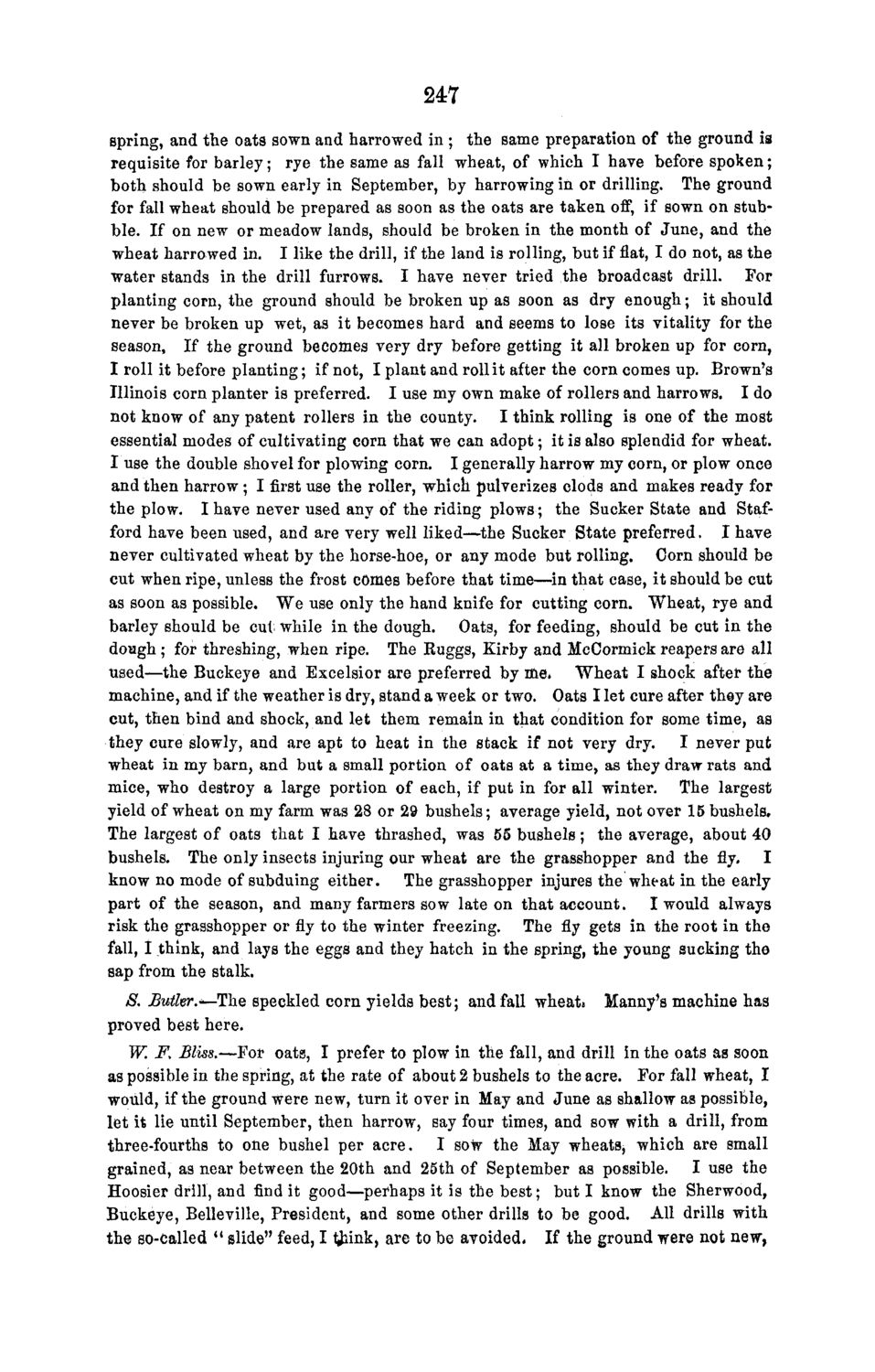| |
| |
Caption: Board of Trustees Minutes - 1868
This is a reduced-resolution page image for fast online browsing.

EXTRACTED TEXT FROM PAGE:
247 spring, and the oats sown and harrowed in ; the same preparation of the ground is requisite for barley; rye the same as fall wheat, of which I have before spoken; both should be sown early in September, by harrowing in or drilling. The ground for fall wheat should be prepared as soon as the oats are taken off, if sown on stubble. If on new or meadow lands, should be broken in the month of June, and the wheat harrowed in. I like the drill, if the land is rolling, but if flat, I do not, as the water stands in the drill furrows. I have never tried the broadcast drill. For planting corn, the ground should be broken up as soon as dry enough; it should never be broken up wet, as it becomes hard and seems to lose its vitality for the season, If the ground becomes very dry before getting it all broken up for corn, I roll it before planting; if not, I plant and roll it after the corn comes up. Brown's Illinois corn planter is preferred. I use my own make of rollers and harrows. I do not know of any patent rollers in the county. I think rolling is one of the most essential modes of cultivating corn that we can adopt; it is also splendid for wheat. I use the double shovel for plowing corn. I generally harrow my corn, or plow once and then harrow ; I first use the roller, which pulverizes clods and makes ready for the plow. I have never used any of the riding plows; the Sucker State and Stafford have been used, and are very well liked—the Sucker State preferred. I have never cultivated wheat by the horse-hoe, or any mode but rolling. Corn should be cut when ripe, unless the frost comes before that time—in that case, it should be cut as soon as possible. We use only the hand knife for cutting corn. Wheat, rye and barley should be cut while in the dough. Oats, for feeding, should be cut in the dough; for threshing, when ripe. The Ruggs, Kirby and McCormick reapers are all used—the Buckeye and Excelsior are preferred by me* Wheat I shock after the machine, and if the weather is dry, stand a week or two. Oats I let cure after they are cut, then bind and shock, and let them remain in that condition for some time, as they cure slowly, and are apt to heat in the stack if not very dry. I never put wheat in my barn, and but a small portion of oats at a time, as they draw rats and mice, who destroy a large portion of each, if put in for all winter. The largest yield of wheat on my farm was 28 or 29 bushels; average yield, not over 15 bushels. The largest of oats that I have thrashed, was 55 bushels; the average, about 40 bushels. The only insects injuring our wheat are the grasshopper and the fly. I know no mode of subduing either. The grasshopper injures the wheat in the early part of the season, and many farmers sow late on that account. I would always risk the grasshopper or fly to the winter freezing. The fly gets in the root in the fall, I think, and lays the eggs and they hatch in the spring, the young sucking the sap from the stalk. JS. Butler. —-The speckled corn yields best; and fall wheats proved best here. Manny's machine has W. F. Bliss.—For oats, I prefer to plow in the fall, and drill in the oats as soon as possible in the spring, at the rate of about 2 bushels to the acre. For fall wheat, I would, if the ground were new, turn it over in May and June as shallow as possible, let it lie until September, then harrow, say four times, and sow with a drill, from three-fourths to one bushel per acre. I sow the May wheats, which are small grained, as near between the 20th and 25th of September as possible. I use the Hoosier drill, and find it good—perhaps it is the best; but I know the Sherwood, Buckeye, Belleville, President, and some other drills to be good. All drills with the so-called " slide" feed, I tfnnk, are to be avoided. If the ground were not new,
| |